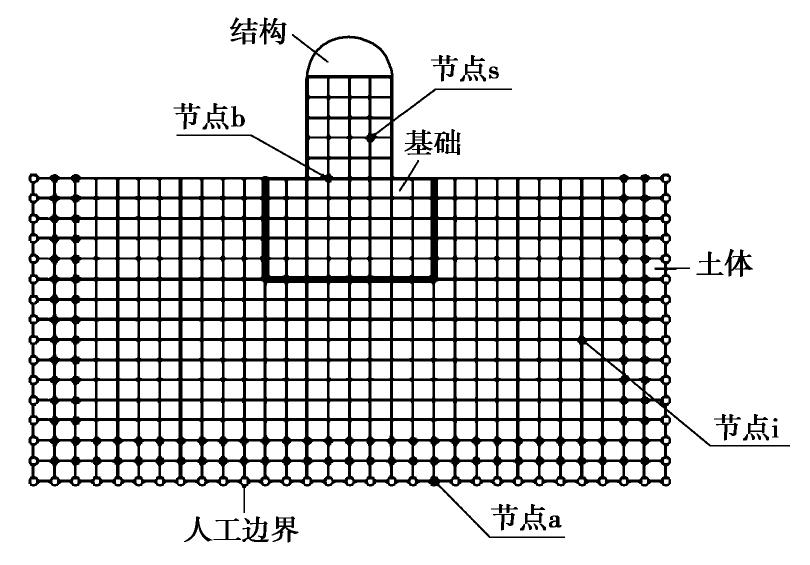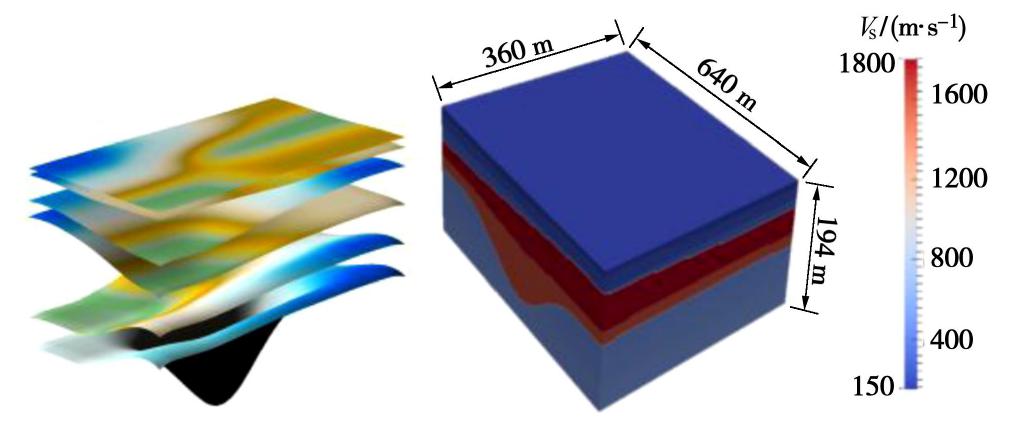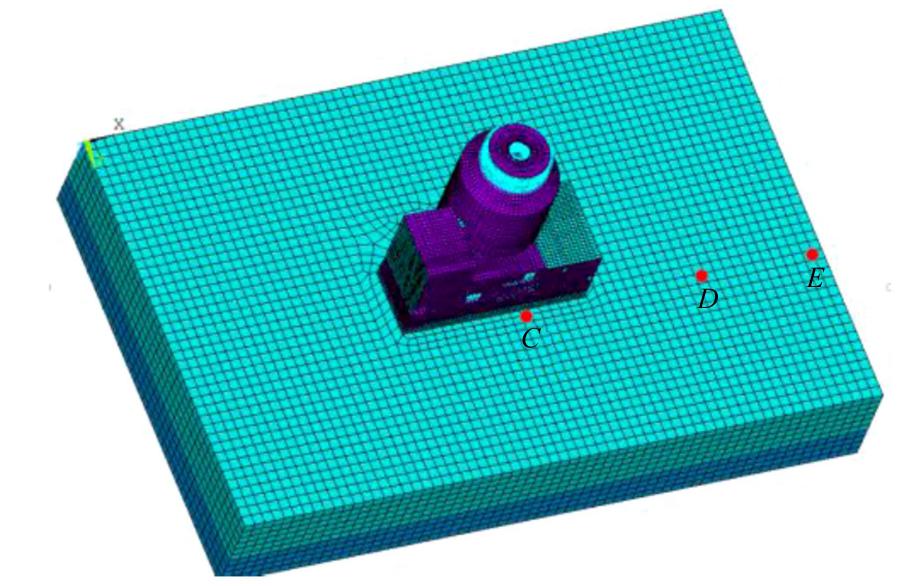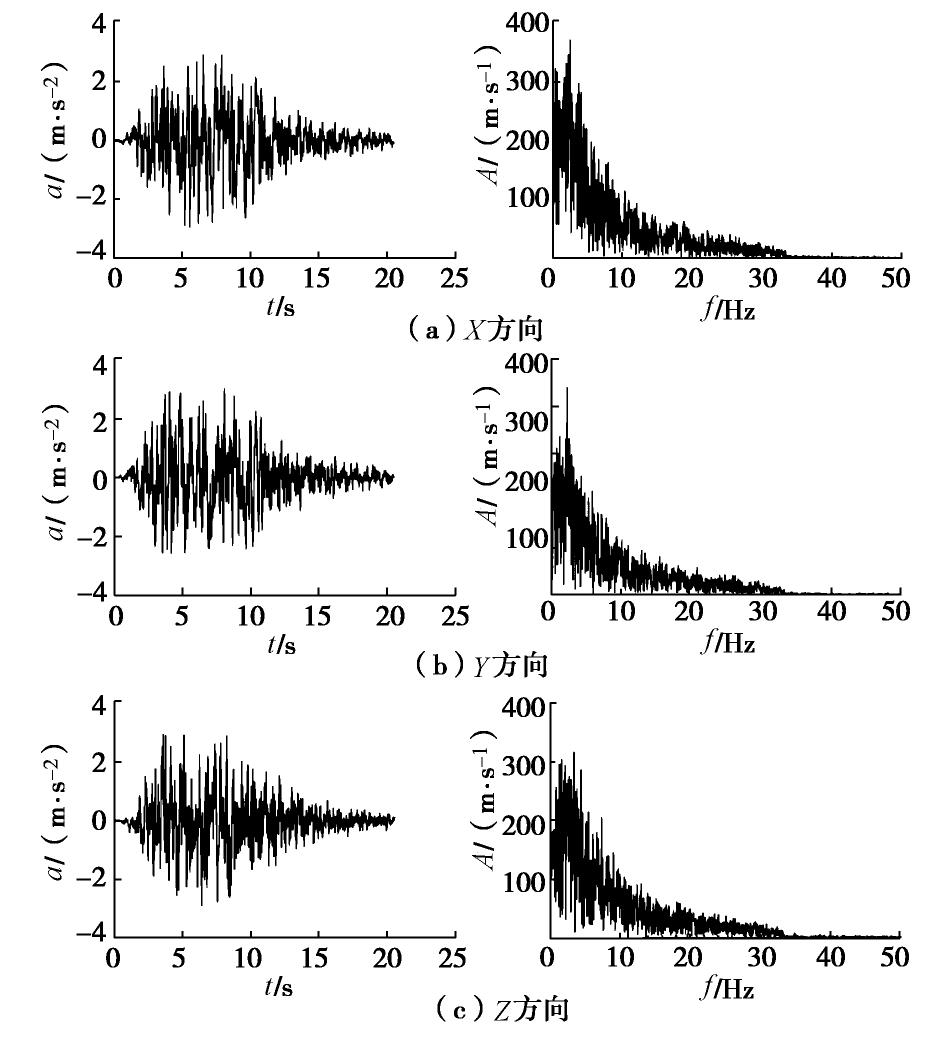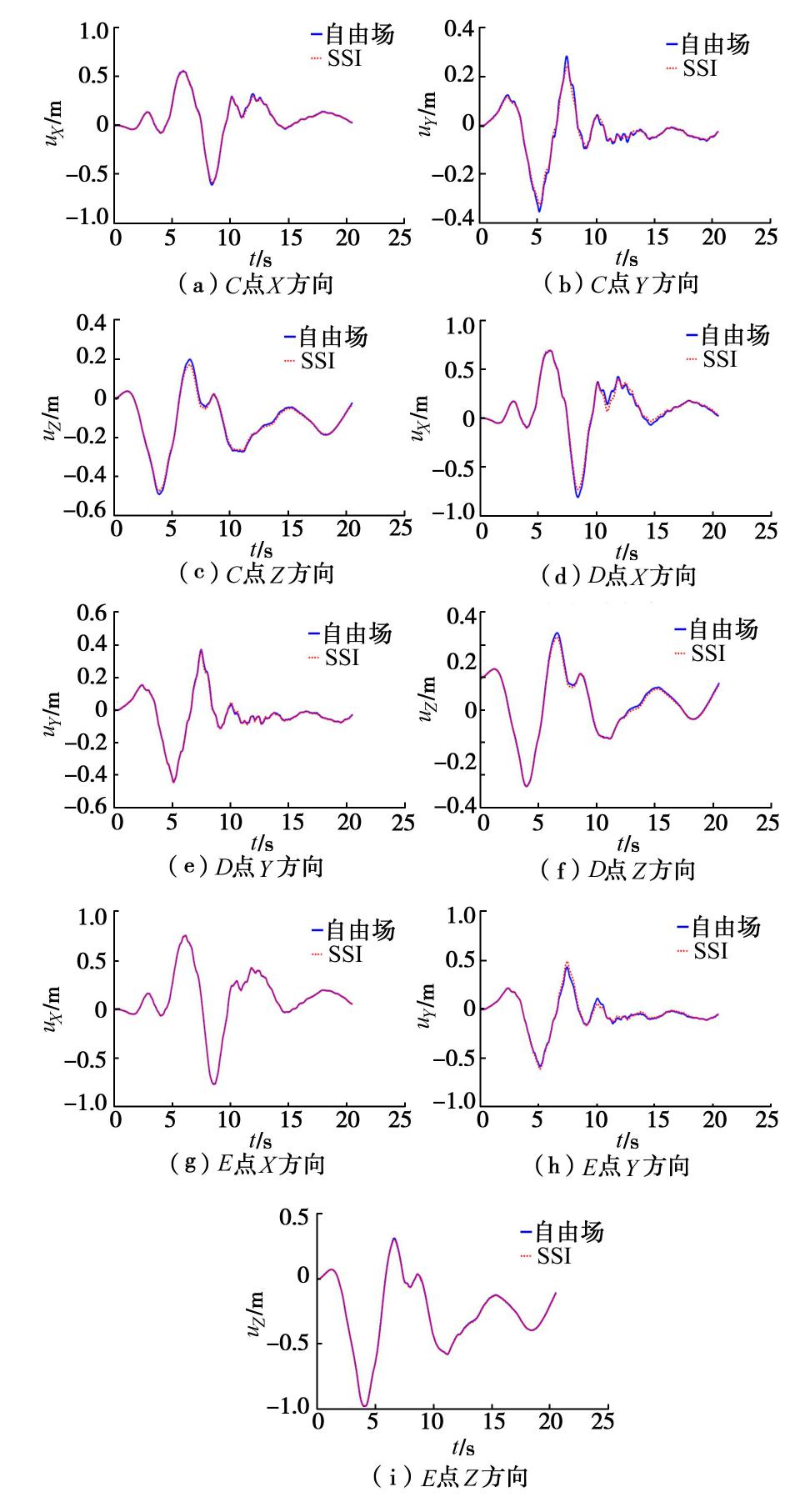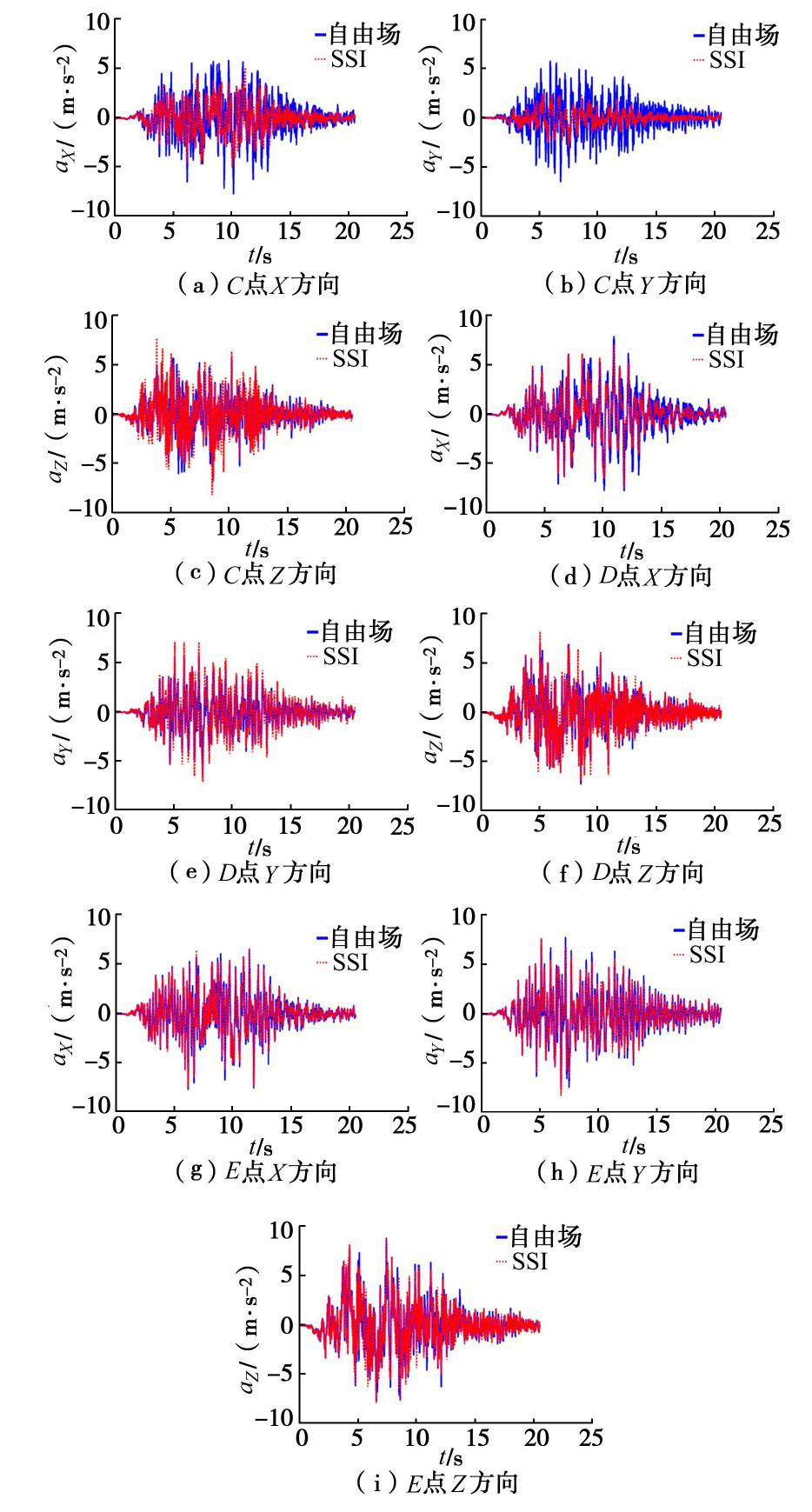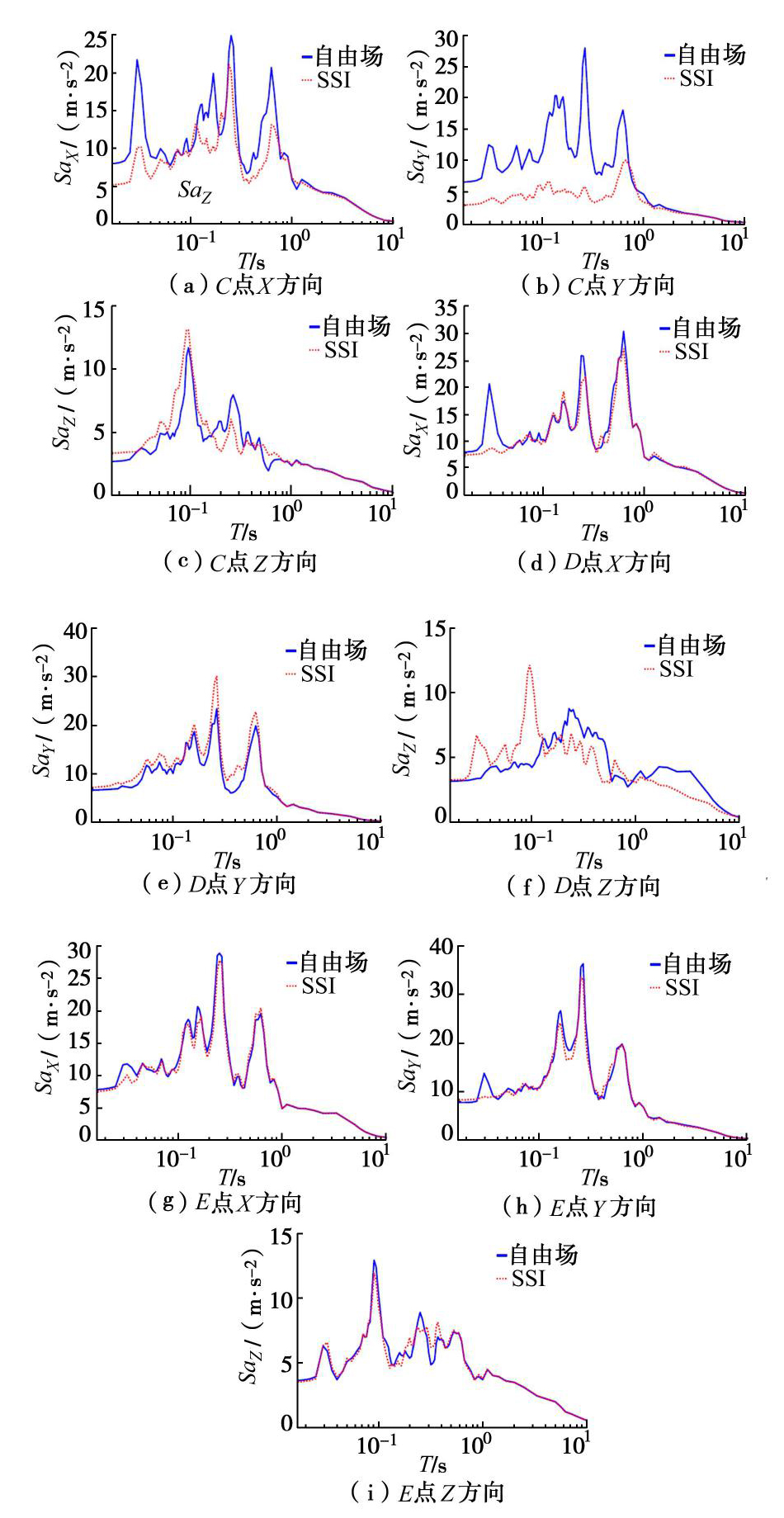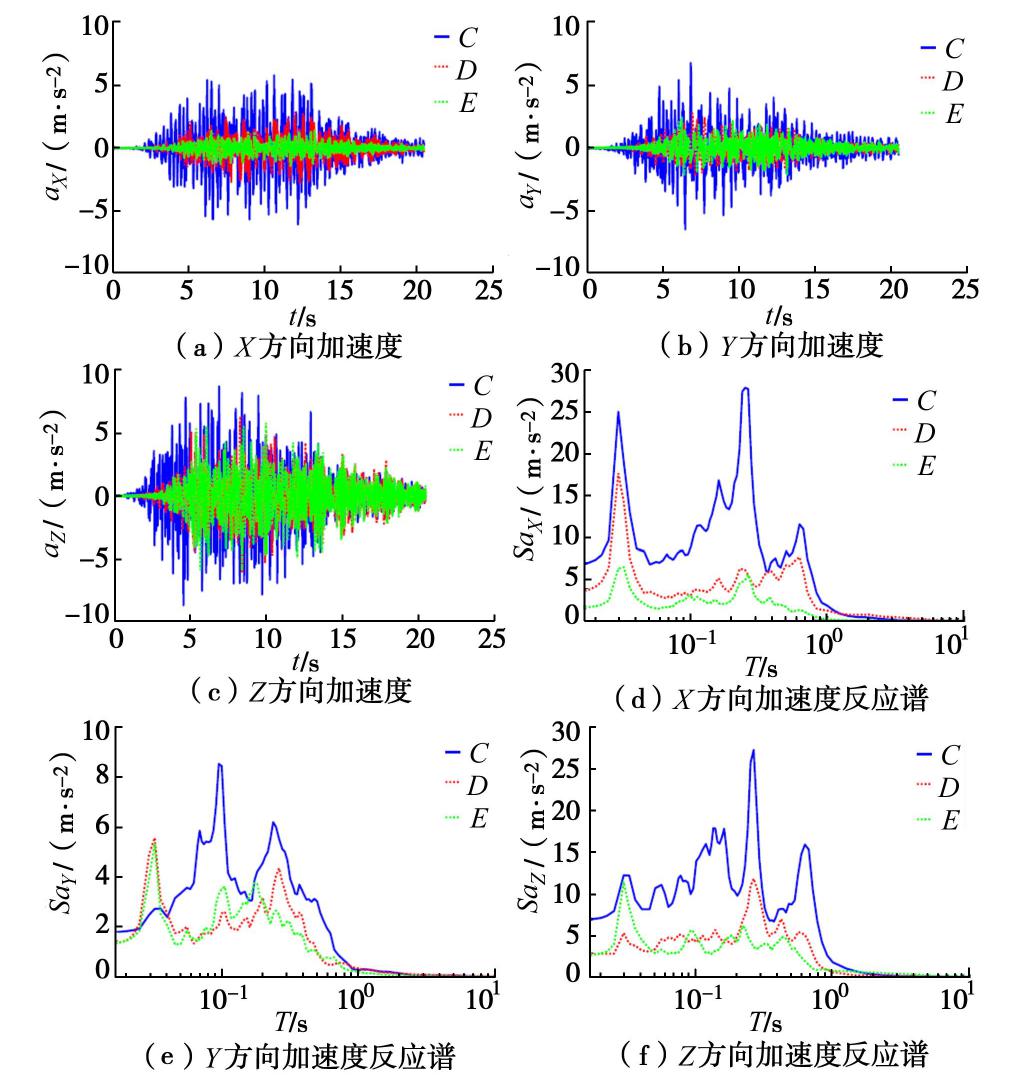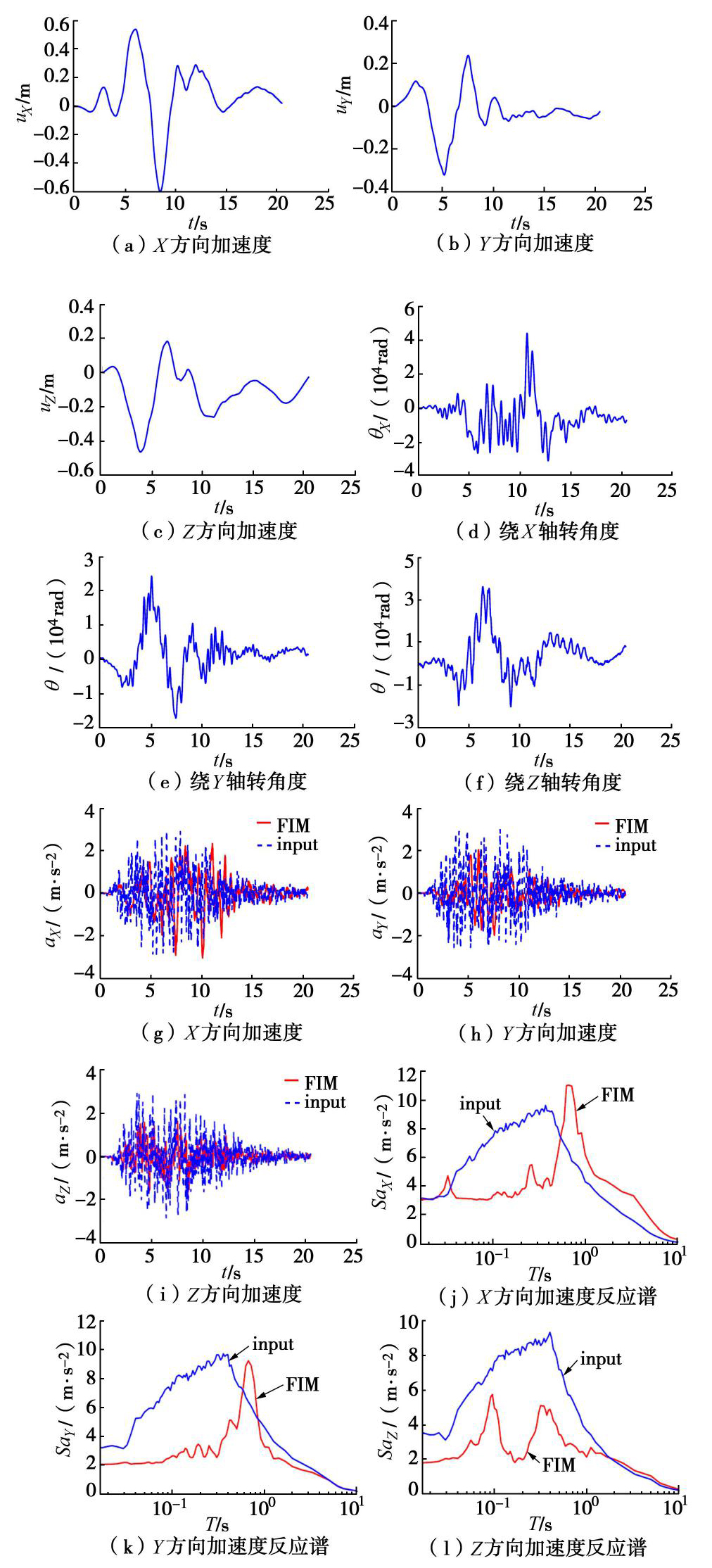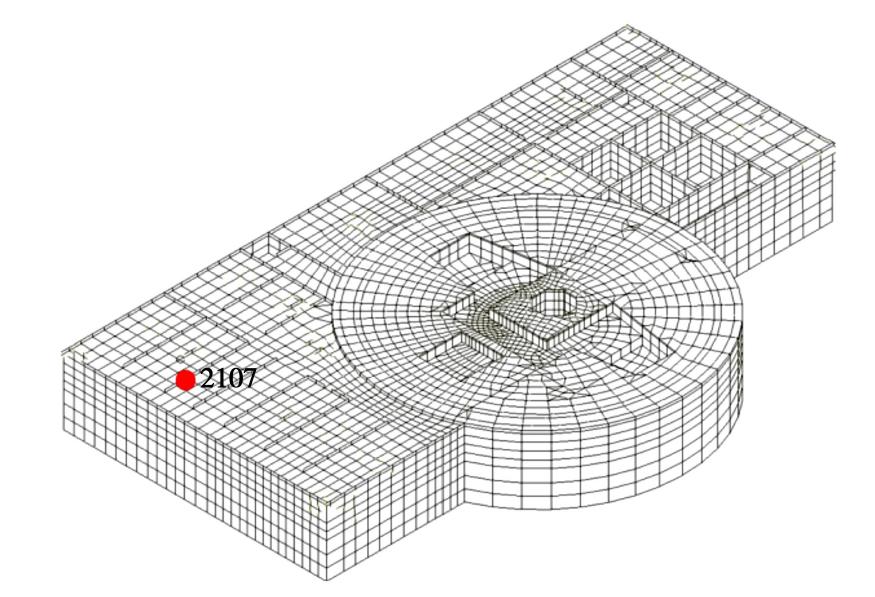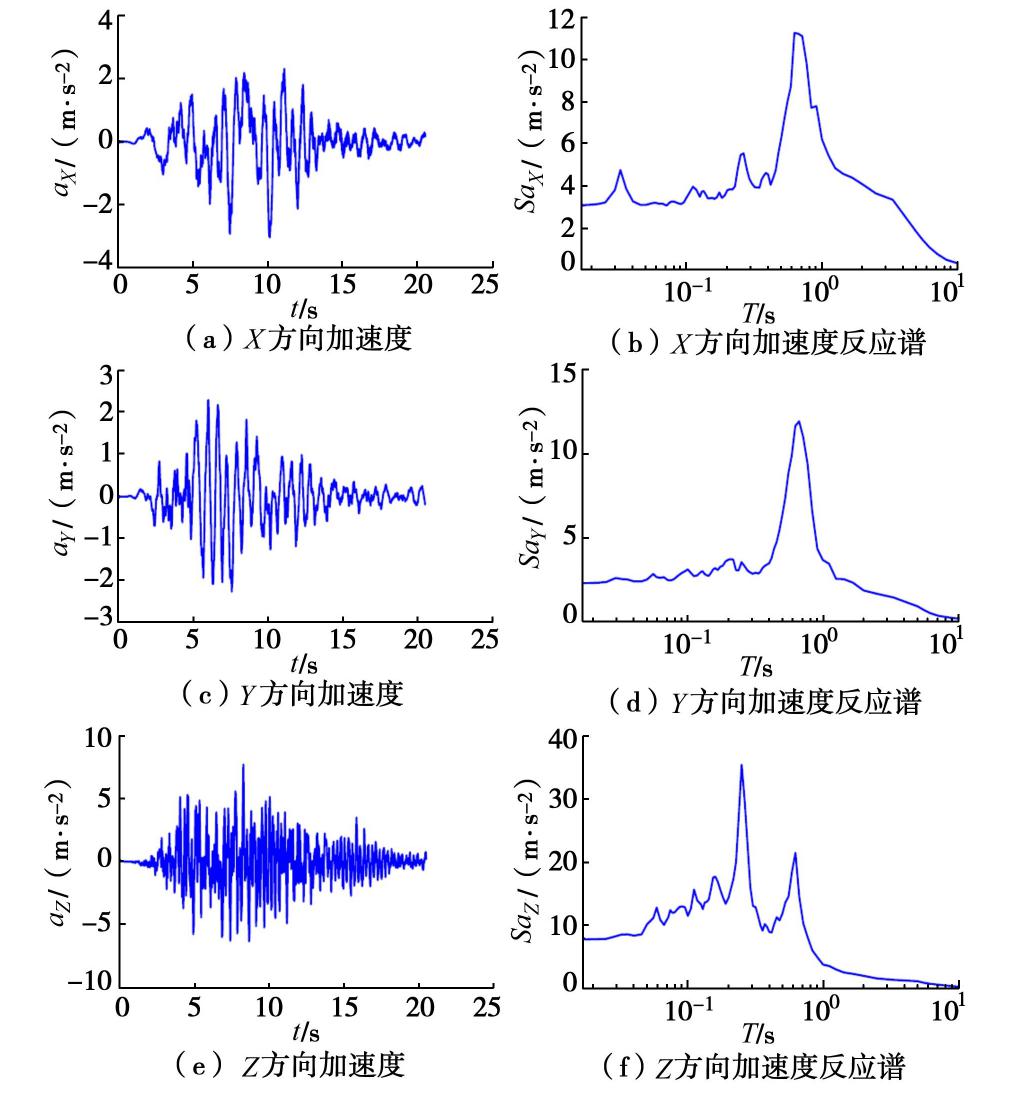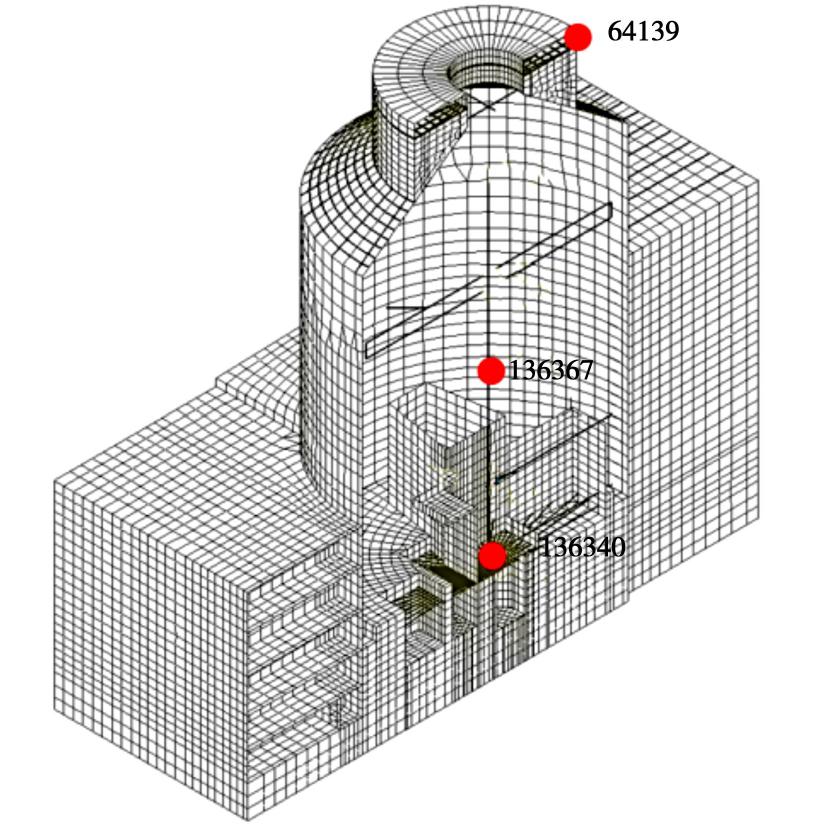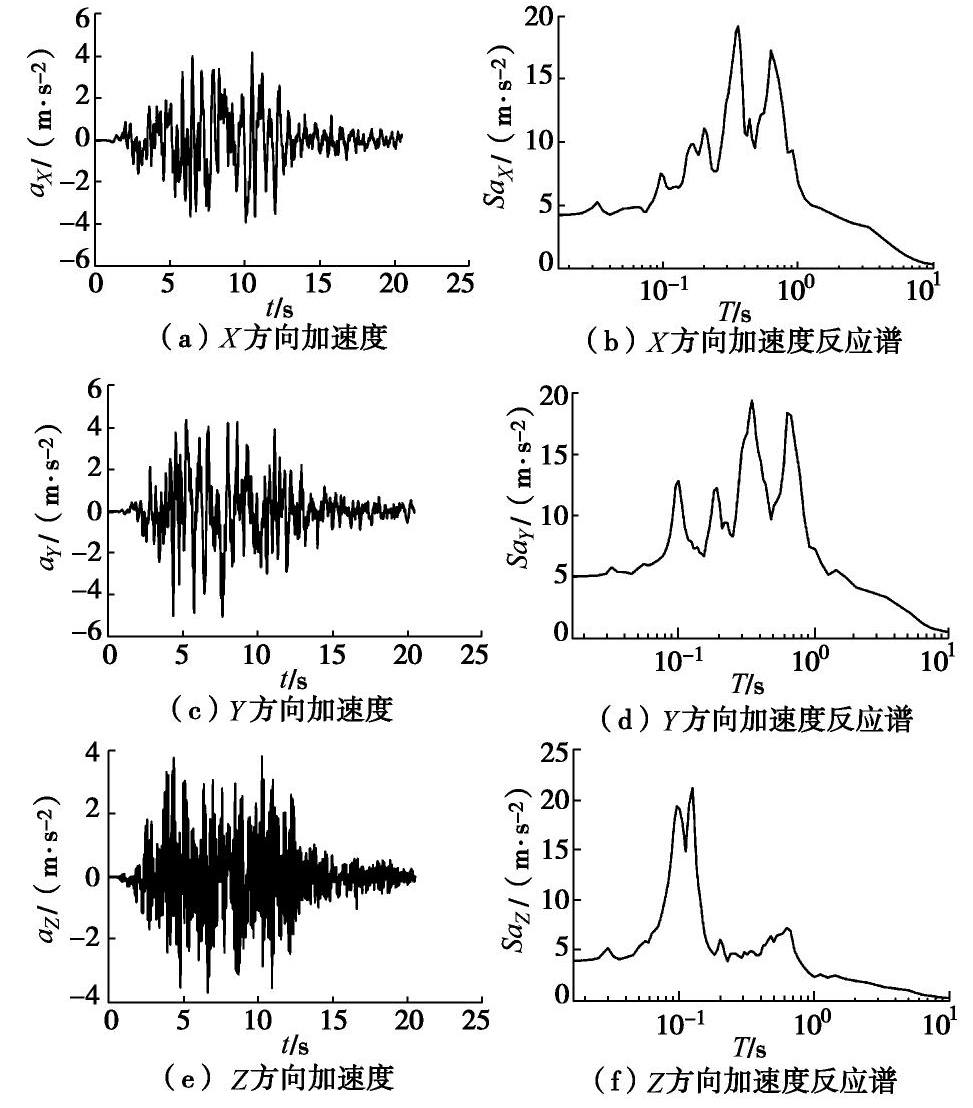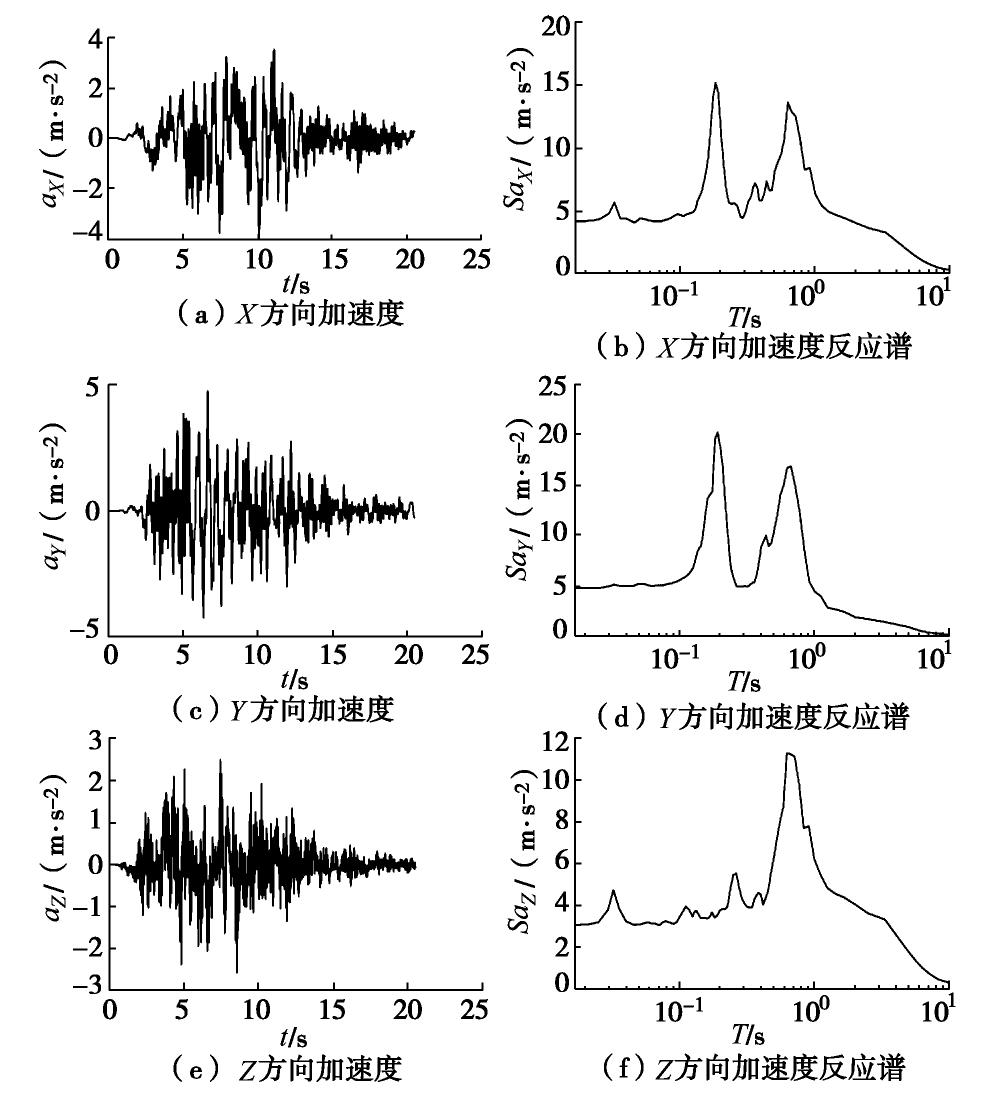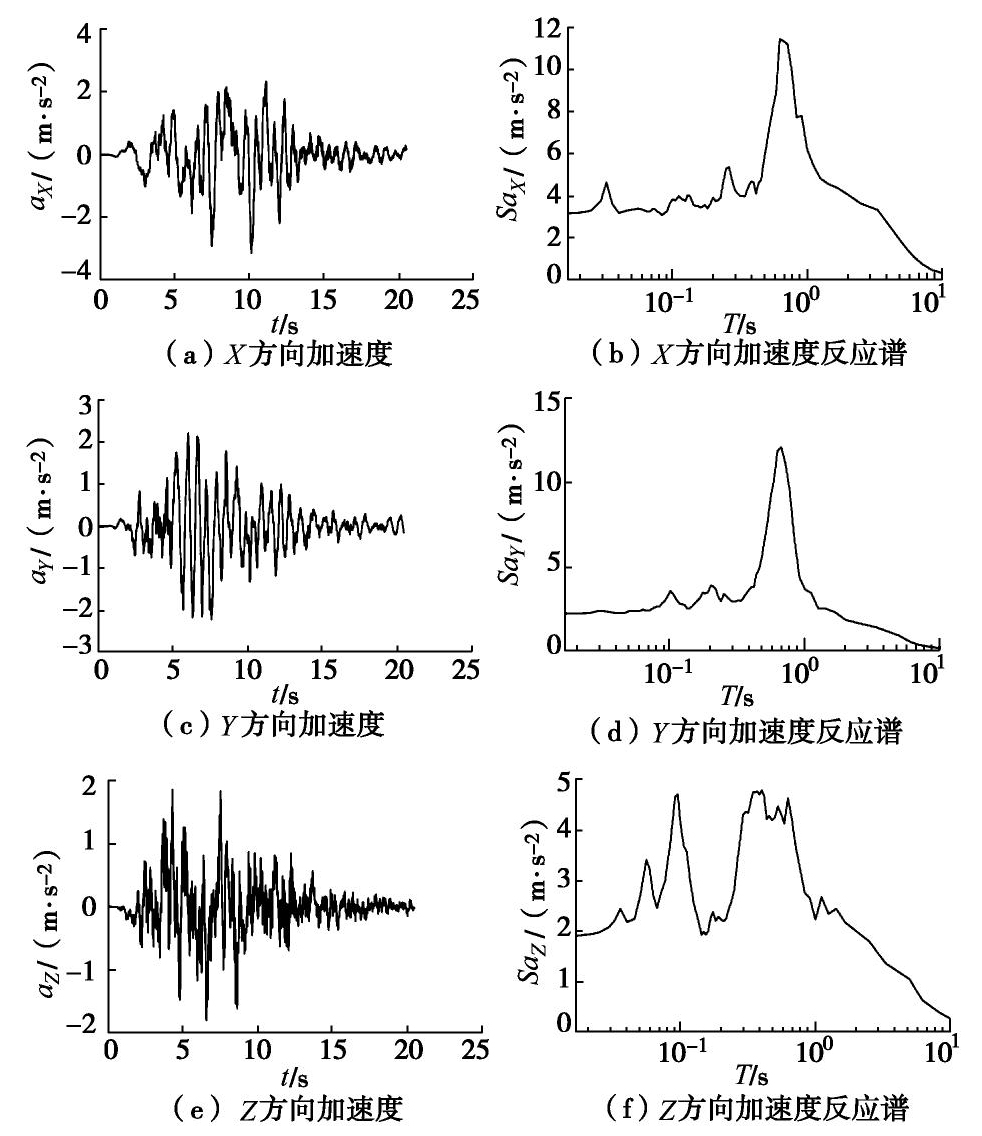Time-domain soil-structure interaction analysis of nuclear facilities on non-horizontal layered site
-
摘要: 目前核电土-结相互作用分析的主流软件SASSI,采用频域等效线性化,不能很好地考虑土体强非线性,且仅适合于水平成层场地。时域土-结相互作用分析方法可以考虑土体强非线性以及非水平成层场地,但效率较低,难于用于实际工程。采用一种高效的时域土-结构动力相互作用分析的分区算法,地基无限域通过集中质量显式有限元和黏弹性人工边界进行模拟,上部结构通过隐式有限元方法进行分析,两者可采用不同的时间步距,并通过MPI通信协议,实现并行计算。以某一核电结构模型为例,分析了某非水平成层场地上核电结构在三向地震波输入下的反应,验证了该方法的高效性和用于大型实际工程的可行性。Abstract: The state-of-the-practice soil-structure interaction (SSI) of nuclear facilities are analyzed using the frequency-domain approaches, represented by the SASSI program. SASSI incorporates the strain-dependent characteristics of soils only indirectly, via the equivalent-linear method, and cannot account for non-horizontal layered soil case. SSI analysis in the time domain may capture non-linearity of materials in the soils and geometric nonlinearity in the foundation (gapping and sliding), but now it is not efficient in practice. In this study, a computationally efficient explicit-implicit FEM in parallel manner to analyze the response of three-dimensional soil-structure system subjected to three-direction seismic waves is proposed. The unbounded soil is modelled by the lumped-mass explicit finite element method and viscoelastic artificial boundary, the structure is analyzed by the implicit finite element method, and the response of the rigid foundation is calculated by the explicit time integration scheme. Different time steps can be chosen for the explicit and implicit integration scheme, which can greatly improve the efficiency. The synchronous parallel algorithms using MPI are used. The codes for this method are programmed. An example for seismic response analysis of a nuclear plant on non-horizontal layered site is given to validate the feasibilty and efficiency of the proposed method.
-
0. 引言
随着中国工业化、城镇化发展进程的加快,港口航道泥沙淤积、河湖库底泥淤积现象严重[1]。淤积底泥大大降低了港口航道通航和调蓄洪水的能力,造成河湖库水质污染、水体恶化,对河道及周边环境造成污染[2]。为保证良好的水质及便利的通航条件,中国每年都清淤出数10亿m3以上的疏浚淤泥[3]。疏浚出的淤泥主要为细颗粒黏土,具有含水率高、不排水强度低、渗透性小等性质,难以在工程上直接利用,一般需要设置淤泥堆场[4]。由于高含水率和高黏粒含量,泥浆在堆场内天然自重落淤固结缓慢,导致长期占用大量土地资源,还易造成周边环境受到污染[5]。
为了加快土颗粒与水的分离,通过加入絮凝剂使土颗粒凝聚快速沉降[6]。章荣军等[7]开展室内絮凝-堆载预压试验,结果表明加入絮凝剂能够增大预压后淤泥的结构屈服应力。无机絮凝剂由于成本低,絮凝效果较好,已广泛应用于淤泥脱水处理中。袁国辉等[8]采用无机絮凝剂CaCl2优化传统电渗法,提高了淤泥后期的排水效率。刘飞禹等[9]利用无机絮凝剂FeCl3和Al2(SO4)3对电渗法处理河道疏浚淤泥进行预处理,明显改善电渗排水效果。上述研究大多集中在絮凝剂对疏浚淤泥沉降性能及对后续脱水工艺影响的研究,针对絮凝脱水后的水质与淤泥沉降性能之间的关联少有涉及,上覆水水质也是衡量絮凝药剂脱水性能的一项重要指标。在实际工程中,上覆水水质达到一定的排放标准才可以进行排放。
鉴于此,本文选取5种典型的无机絮凝剂对疏浚淤泥进行调理,开展一系列量筒试验,探讨絮凝剂种类及掺量对淤泥沉积特性及出水水质的影响,并初步确定最优絮凝剂及其最优掺量。通对过自重沉积固结稳定后沉降量、沉降速率、沉积稳定时间及上覆水浊度值进行分析,筛选出高效脱水且保证尾水排放达标的絮凝剂,以期为吹填淤泥快速落淤过程中的药剂选择和余水处理提供借鉴参考。
1. 试验材料与方案
1.1 试验材料
本文所用的疏浚淤泥取自西太湖宜兴周铁堆场,经网筛去除较大砾石和垃圾。通过一系列室内试验,测得淤泥的主要物理性质见表 1,粒径分布曲线见图 1。根据细粒土的分类标准,该淤泥属于高液限黏土(CH)。试验初步选用无机絮凝剂CaCl2、Ca(OH)2,PAC(聚合氯化铝),PAS(聚合硫酸铝),PAFSI(聚合硅酸铝铁)。
表 1 淤泥的基本物理性质Table 1. Basic physical properties of dredged materials含水率/% 液限/% 塑限/% 塑性指数 黏粒含量①/% 相对质量密度 有机质含量②/% 100.4 55.9 20.6 35.3 28.00 2.72 0.75 注:①粒径小于5 μm;②重铬酸钾容量法。 1.2 试验方案
试验前先将现场取回的淤泥过筛去除淤泥中较大的石子和其它杂质,配制成含水率为220%(4倍液限)的试验淤泥。采用下式计算出原状淤泥中需要添加蒸馏水的质量mw:
mw=w1−w01+w0m1。 (1) 式中:w0为原状淤泥含水率;w1为试验淤泥初始含水率;m1为原状淤泥的质量。加水混合后淤泥放在六连搅拌器上持续搅拌直至均匀。
为初步明确絮凝剂对高含水率疏浚淤泥自重沉积特性的影响,5种絮凝剂统一配制成100 mL目标浓度为1%的絮凝剂溶液。试验选用规格为500 mL的玻璃量筒。取400 mL的混合液倒入量筒,倒入过程中用玻璃棒进行引流,结束后用保鲜膜密闭封顶,以防水分散失。待泥水分离界面高度不再有明显变化时停止观察,记录不同时刻泥水分界面高度变化的相关试验数据,试验结束后检测余水浊度值。
根据前期沉降试验结果,得出CaCl2,PAS在沉积稳定时沉降量相对较大,分别降至187,198 mL。根据试验结果,初步筛选出CaCl2、PAS为最优絮凝剂,改变其掺量,具体试验方案见表 2。
表 2 量筒沉积试验方案Table 2. Schemes of measuring cylinder sedimentation tests加药种类 絮凝剂掺量/% CaCl2 0,0.5,0.8,0.9,1.0,1.2 PAS 0,0.1,0.2,0.5,0.7,1.0 2. 试验结果与分析
2.1 泥面沉降曲线
图 2为5种絮凝剂在目标浓度下泥水分离界面随时间变化的沉降曲线。在絮凝前期,PAFSI和PAC展现出良好的脱水性能,促使淤泥沉降效果较明显。直至72 h后,添加CaCl2和PAS的泥浆混合液沉降效果较好,最终沉降量较低。添加Ca(OH)2的泥浆混合液在前期絮凝沉降效果较好,在72 h后沉降基本不发生变化。根据初步沉降试验结果,以下试验选定最优絮凝剂为CaCl2和PAS,改变其掺量。
图 3为不同CaCl2掺量下泥水分界面随时间变化的沉降曲线。当CaCl2掺量为0.8%时,泥面沉降体积值达到最低,显著改善了疏浚淤泥的脱水性能。最终淤泥沉降体积值随CaCl2掺量的增加,呈先降低再上升的变化趋势。这是由于Ca2+通过离子交换和电中和作用,压缩黏土颗粒表面双电层厚度,使得颗粒间斥力降低,颗粒更易聚集沉降。随着CaCl2掺量的增加,黏土颗粒表面的负电荷全部中和,此时絮凝效果达到最佳。随着掺量进一步增加,黏土颗粒表面带正电荷,颗粒间的斥力增大,絮凝效果开始减弱。
图 4为不同PAS掺量下泥水分离界面沉降曲线。可以看出,当PAS掺量在0.2%时,泥面沉降量最低。随着PAS掺量的增加,土颗粒相互碰撞次数增多,发生吸附架桥,凝聚沉降作用。当PAS掺量达到一定时,颗粒间的排斥能为零,絮凝效果最好,最终沉降量较大。当PAS掺量的进一步增大时,水中存在较多聚合铝离子带正电,完全附着在黏土颗粒表面使得其带上正电荷,颗粒之间的斥力增加,絮凝效果开始减弱。
2.2 泥水分界面沉降速率
泥面沉降速率按照下式进行计算:
v=Si+1−Siti+1−ti。 (2) 式中:Si+1,Si分别为ti+1,ti时刻泥水分离界面沉降量。
对不同CaCl2,PAS掺量下淤泥沉降速率进行计算,结果如图 5所示。在不同絮凝剂掺量条件下,沉积速率的变化大致分为3个阶段。①第一阶段在泥水分界面刚出现时沉降速率较大,曲线呈快速下降趋势,淤泥沉降速率较大。②第二阶段细小的土颗粒絮凝成团胶结成大的聚体,絮凝团之间相互阻碍开始沉降,沉降速率快速降低直至一个稳定区间范围内。③第三阶段沉降速率变化极为平缓,随着时间的推移,淤泥自重沉降固结趋于稳定时,沉降速率趋近于零。由于在水下受到浮力作用,固结变形仍在缓慢进行。
2.3 沉降稳定时间Tc
疏浚淤泥在沉降过程中,泥水分离界面沉降速率不是固定的。参考Imai对泥浆自重沉降稳定时间Tc的定义[10],根据沉降过程中泥水分离界面随时间在半对数坐标系下的沉降变化曲线,计算不同絮凝剂掺量下泥浆自重沉降稳定时间Tc。泥浆沉降稳定时间确定方法示意图如图 6所示,具体结果见表 3。
表 3 不同絮凝剂掺量下淤泥自重沉积稳定时间Table 3. Stabilization time of self-weight sedimentation of sludge under different flocculant dosages絮凝剂 CaCl2/PAS 掺量/% 0 0.5/0.1 0.8/0.2 0.9/0.5 1.0/0.7 1.2/1.0 Tc/d 3.39 2.63/2.65 2.54/2.58 2.58/2.60 2.77/2.61 2.80/2.63 在添加0.8%CaCl2和0.2%PAS掺量下,混合液泥浆能较快地达到自重沉积稳定状态,沉降稳定时间较短,分别为2.54,2.6 d。
2.4 出水水质
对加入5种典型无机絮凝剂的混合泥浆液7 d沉降稳定后余水浊度值进行检测,结果如图 7所示。可以发现加入絮凝剂可大大降低余水的浊度值。CaCl2,PAS的去浊效果相对较优,且能够降低淤泥pH值。
在初步选定最优絮凝剂CaCl2,PAS的基础上,对不同掺量下混合泥浆自重沉降稳定后上覆水的浊度值进行测定。
结合图 8可发现,絮凝剂PAS在掺量为0.2%时,去浊率较高;絮凝剂CaCl2掺量为0.8%时可达到相同的去浊效果。达到相同的去浊效果时,PAS掺量较少。当CaCl2的掺量为0.8%时,去除率达到83.18%。当PAS的掺量为0.2%时,浊度去除率达到84%。这可能是由于PAS具有较大的比表面积,水解后产生较多的带正电粒子,能够与淤泥颗粒表面带负电粒子充分接触发生电性中和,使得颗粒失去稳定状态进而沉降下沉。
3. 结论
(1)通过5种典型无机絮凝剂的絮凝沉降试验,添加无机絮凝剂可大大加快高含水率疏浚淤泥的沉降速率,最终沉降量较低且余水相对清澈。对5种絮凝剂在目标浓度下泥浆自重沉积稳定后的沉降量进行观察,PAFSI,PAC和Ca(OH)2前期絮凝较快,CaCl2,PAS后期沉降较快,最终泥水分离界面沉降值较低。
(2)CaCl2,PAS表现出良好的脱水性能,CaCl2主要通过离子交换作用和电性中和发挥絮凝作用;PAS主要通过中和土颗粒表面负电荷发挥絮凝作用。CaCl2,PAS的最优掺量为0.8%,0.2%。在最优掺量下,浊度去除率分别为83.2%,84.5%,沉降稳定时间缩短至2.54,2.57 d。
-
表 1 土体参数
Table 1 Parameters of soils
土体种类 密度/(kg·m-3) vs /(m·s-1)vP /(m·s-1)泊松比 阻尼比 1 1800 150 1942 0.497 0.05 2 1950 180 2097 0.497 0.05 3 1900 240 2204 0.494 0.05 4 1950 320 2090 0.488 0.05 5 2450 1800 3817 0.357 0.05 6 2800 1600 3825 0.394 0.05 7 1600 539 1451 0.420 0.05 8 1600 541 1455 0.420 0.05 9 1600 543 1459 0.420 0.05 10 1600 545 1465 0.420 0.05 11 1600 547 1469 0.420 0.05 12 1600 549 1475 0.420 0.05 13 1600 550 1481 0.420 0.05 14 1600 552 1486 0.420 0.05 15 1600 554 1491 0.420 0.05 16 1600 556 1496 0.420 0.05 17 1600 558 1501 0.420 0.05 18 1600 560 1507 0.420 0.05 19 1600 562 1513 0.420 0.05 20 1600 564 1519 0.420 0.05 21 1600 566 1525 0.420 0.05 22 1600 562 1513 0.420 0.05 注: vs 为剪切波速,vP 为压缩波速。 -
[1] Seismic Analysis of Safety-Related Nuclear Structure[S]. ASCE Standard, ASCE/SEI4-16.
[2] KAUSEL E. Early history of soil-structure interaction[J]. Soil Dynamics & Earthquake Engineering, 2010, 30(9): 822-832.
[3] LOU M, WANG H, CHEN X, et al. Structure-soil-structure interaction: Literature review[J]. Soil Dynamics & Earthquake Engineering, 2011, 31(12): 1724-1731.
[4] OSTADAN F, DENG N. Computer Program: SASSI2010 - A System for Analysis of Soil-Structure Interaction. Version1.1[R]. San Francisco: Geotechnical and Hydraulic Engineering Services, Bechtel National Inc., 2011.
[5] COLEMAN J L, BOLISETTI C, WHITTAKER A S. Time-domain soil-structure interaction analysis of nuclear facilities[J]. Nuclear Engineering and Design, 2016, 298: 264-270. doi: 10.1016/j.nucengdes.2015.08.015
[6] JEREMIC B, JIE, G, PREISIG M, et al. Time domain simulation of soil-foundation-structure interaction in non-uniform soils[J]. Earthquake Engineering Structure Dynamic, 2009, 38(5): 699-718. doi: 10.1002/eqe.896
[7] BIELAK J, LOUKAKIS K, HISADA Y, et al. Domain reduction method for three-dimensional earthquake modeling in localized regions: part-I theory[J]. Bulletin of the Seismological Society of America, 2003, 93(2): 817-824. doi: 10.1785/0120010251
[8] BOLISETTI C, WHITTAKER A S, MASON H B, et al. Equivalent linear and nonlinear site response analysis for design and risk assessment of safety-related nuclear structures[J]. Nuclear Engineering and Design, 2014, 275(8): 107-121.
[9] KABANDA J, KWON O S, KWON G. Time and frequency domain analyses of the Hualien Large-Scale Seismic Test[J]. Nuclear Engineering and Design, 2015, 295: 261-275. doi: 10.1016/j.nucengdes.2015.10.011
[10] 廖振鹏. 工程波动理论导论[M]. 2版.北京: 科学出版社, 2002: 136-285. LIAO Zhen-peng. Introduction to Wave Motion Theories in Engineering[M]. 2nd ed. Beijing: Science Press, 2002: 136-285. (in Chinese)
[11] 杨笑梅, 赖强林. 二维土层地震反应分析的时域等效线性化解法[J]. 岩土力学, 2017, 38(3): 847-856. https://www.cnki.com.cn/Article/CJFDTOTAL-YTLX201703030.htm YANG Xiao-mei, LAI Qiang-lin. Time-domain equivalent linearization method for two-dimensional seismic response analysis[J]. Rock and Soil Mechanics, 2017, 38(3): 847-856. (in Chinese) https://www.cnki.com.cn/Article/CJFDTOTAL-YTLX201703030.htm
[12] 陈少林, 唐敢, 刘启方, 等. 三维土-结构动力相互作用的一种时域直接分析方法[J]. 地震工程与工程振动, 2010, 30(2): 24-31. https://www.cnki.com.cn/Article/CJFDTOTAL-DGGC201002006.htm CHEN Shao-lin, TANG Gan, LIU Qi-fang, et al. A direct time-domain method for analysis of three-dimensional soil-structure dynamic interaction[J]. Earthquake Engineering and Engineering Vibration, 2010, 30(2): 24-31. (in Chinese) https://www.cnki.com.cn/Article/CJFDTOTAL-DGGC201002006.htm
[13] 杨笑梅, 关慧敏, 张学胜, 等. 分析三维土-结构动力相互作用体系等效输入的时域显式有限元法[J]. 土木工程学报, 2010, 43(增刊1): 535-540. https://www.cnki.com.cn/Article/CJFDTOTAL-TMGC2010S1094.htm YANG Xiao-mei, GUAN Min-hui, ZHANG Xue-sheng, et al. The explicit finite element method in time domain for analysis of equivalent input of three-dimensional dynamic SSI system[J]. China Civil Engineering Journal, 2010, 43(S1): 535-540. (in Chinese) https://www.cnki.com.cn/Article/CJFDTOTAL-TMGC2010S1094.htm
[14] 陈少林, 赵宇昕. 一种三维饱和土-基础-结构动力相互作用分析方法[J]. 力学学报, 2016, 48(6): 1362-1371. https://www.cnki.com.cn/Article/CJFDTOTAL-LXXB201606011.htm CHEN Shao-lin, ZHAO Yu-xin. A method for three- dimensional satutarted soil-foundation-structure dynamic interaction analysis[J]. Theoretical and Applied Mechanics, 2016, 48(6): 1362-1371. (in Chinese) https://www.cnki.com.cn/Article/CJFDTOTAL-LXXB201606011.htm
[15] 刘启方, 丁海平, 袁一凡, 等. 三维地震断层动力破裂的显式并行有限元解法[J]. 地震工程与工程振动, 2003, 23(4): 22-28. https://www.cnki.com.cn/Article/CJFDTOTAL-DGGC200304004.htm LIU Qi-fang, DING Hai-ping, YUAN Yi-fan, et al. An explicit parallel finite-element method of dynamic rupture in 3D earthquake fault[J]. Earthquake Engineering and Engineering Vibration, 2003, 23(4): 22-28. (in Chinese) https://www.cnki.com.cn/Article/CJFDTOTAL-DGGC200304004.htm
[16] 刘启方. 基于运动学和动力学震源模型的近断层地震动研究[D]. 哈尔滨: 中国地震局工程力学研究所, 2005: 130-133. LIU Qi-fang. Studies on Near-fault Ground Motions Based on Kinematic and Dynamic Source Models[D]. Harbin: Institute of Engineering Mechanics, China Earthquake Administration, 2005: 130-133. (in Chinese)
[17] 陈少林, 王俊泉, 刘启方, 等. 基于显-隐式格式的三维时域土-结相互作用分析的异步并行算法[J]. 中国科学(技术科学), 2017, 47(12): 1321-1330. https://www.cnki.com.cn/Article/CJFDTOTAL-JEXK201712009.htm CHEN Shao-lin, WANG Jun-quan, LIU Qi-fang, et al. Asynchronous parallel algorithm for three-dimensional soil-structure interaction analysis based on explicit-implicit integration scheme[J]. Scientia Sinica (Technologica), 2017, 47(12): 1321-1330. (in Chinese) https://www.cnki.com.cn/Article/CJFDTOTAL-JEXK201712009.htm
[18] FORUM M P I. Document for a Standard Message-Passing Interface[R]. Tennessee: University of Tennessee, 1993: 1735-1749. (in Chinese)
[19] 刘晶波, 李彬. 三维黏弹性静-动力统一人工边界[J]. 中国科学:工程科学材料科学, 2005, 35(9): 966-980. https://www.cnki.com.cn/Article/CJFDTOTAL-JEXK200509008.htm LIU Jing-bo, LI Bin. Three-dimensional viscoelastic static-dynamic unified artificial boundary[J]. Chinese Science: Engineering Science Materials Science, 2005, 35(9): 966-980. (in Chinese) https://www.cnki.com.cn/Article/CJFDTOTAL-JEXK200509008.htm
[20] 谷音, 刘晶波, 杜义欣. 三维一致黏弹性人工边界及等效黏弹性边界单元[J]. 工程力学, 2007, 24(12): 31-37. https://www.cnki.com.cn/Article/CJFDTOTAL-SFXB200905031.htm GU Yin, LIU Jing-bo, DU Yi-xin. 3D consistent viscous- spring artificial boundary and viscous-spring boundary element[J]. Engineering Mechanics, 2007, 24(12): 31-37. (in Chinese) https://www.cnki.com.cn/Article/CJFDTOTAL-SFXB200905031.htm
[21] 章小龙, 李小军, 陈国兴, 等. 黏弹性人工边界等效荷载计算的改进方法[J]. 力学学报, 2016, 48(5): 1126-1135. https://www.cnki.com.cn/Article/CJFDTOTAL-LXXB201605012.htm ZHANG Xiao-long, LI Xiao-jun, CHEN Guo-xing, et al. An improved method of the calculation of equivalent nodal forces in viscous-elastic artificial boundary[J]. Chinese Journal of Theoretical and Applied Mechanics, 2016, 48(5): 1126-1135. (in Chinese) https://www.cnki.com.cn/Article/CJFDTOTAL-LXXB201605012.htm
[22] LIAO Z P, WONG H L. A transmitting boundary for the numerical simulation of elastic wave propagation[J]. Soil Dynamic Earthquake Engineering, 1984, 3(4): 174-183.



 下载:
下载:








